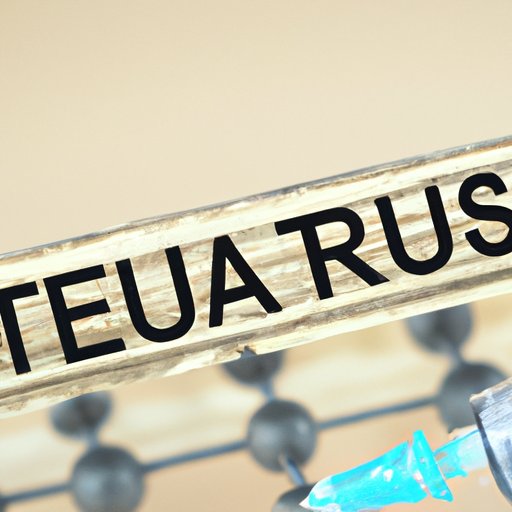
Introduction
Tetanus is a serious bacterial infection that affects the nervous system. It’s caused by the Clostridium tetani bacteria, which produce a powerful toxin that can cause muscle stiffness and spasms, especially in the jaw (also known as lockjaw). While tetanus is rare in developed countries due to widespread vaccination, it can be fatal if left untreated. Rust is often associated with tetanus because of its association with old, decayed metal objects that could be contaminated with the bacteria.
The Myths and Facts About Tetanus: Debunking Rust’s Role in Infection
Contrary to popular belief, rust does not cause tetanus. Instead, the spores of the Clostridium tetani bacteria are found in soil, dust, and manure. When these spores enter the body through a wound, they can grow into a thriving colony and release the neurotoxin that causes tetanus symptoms. It’s worth noting that not all wounds can lead to tetanus; only deep puncture wounds or contaminated wounds that are not properly cleaned are at risk.
So, while it’s true that rusty metal objects could harbor tetanus bacteria, it’s not the rust itself that causes infection. This means that even a clean, new nail could transmit tetanus bacteria if it punctures your skin and the wound is not properly treated.
Should You Be Worried About Tetanus from Rust? An Overview of the Risks
Although tetanus is rare in the United States, the Centers for Disease Control and Prevention (CDC) recommends that everyone receive a tetanus vaccine every 10 years to protect against infection. According to the CDC, there were 30 reported cases of tetanus in the United States in 2019, and of those, 8 were fatal. While it’s difficult to know how many of these cases were caused by rusty objects, it’s clear that tetanus can still pose a serious threat.
It’s important to note that some people may be at higher risk for tetanus infection, including those who have not been vaccinated or those with weakened immune systems. Additionally, people who work in certain professions, such as farming, construction, or gardening, may be more exposed to tetanus bacteria through their work.
From Rusty Nails to Gardening Tools: Understanding How Tetanus Spreads
Tetanus bacteria enter the body through a wound that’s been contaminated with the spores. While deep puncture wounds are often associated with tetanus, any wound that’s not properly cleaned can become a potential entry point for the bacteria. Once inside the body, the bacteria can grow and release the neurotoxin that causes tetanus symptoms.
So, where does rust come in? Rusty metal objects could potentially harbor tetanus bacteria if they’ve been in contact with soil or other sources of the spores. However, it’s not the rust itself that transmits the bacteria. Depending on the type of metal, rust can actually act as a protective barrier that prevents bacteria from thriving on the surface.
Common sources of tetanus bacteria in our environment include soil, dust, and manure, which can all contain the spores that lead to infection. Additionally, animal bites or scratches can transfer the bacteria from an animal’s mouth or paws, making it important to clean these types of wounds as well.
Prevention is Key: How to Protect Yourself from Tetanus
Thankfully, there are steps you can take to protect yourself from tetanus. The most important step is to make sure you’re up-to-date on your tetanus vaccine. The CDC recommends that adults receive a tetanus booster vaccine every 10 years, or after an injury that puts them at risk for tetanus. Children typically receive a series of tetanus vaccines as part of their routine immunizations.
If you do suffer a wound, it’s important to clean it thoroughly with soap and water to remove any dirt or debris. If the wound is deep or has been contaminated (such as a bite wound), you should seek medical attention to determine if a tetanus shot or other treatment is necessary.
Other tips for preventing tetanus include using protective gear when working with potentially contaminated materials, such as gloves and boots, and practicing good hygiene to reduce your risk of infection. Be sure to wash your hands regularly, especially before eating or touching your face, and avoid putting your hands in your mouth or nose.
Tetanus from Rust: What You Need to Know and How to Stay Safe
While rusty objects could potentially harbor tetanus bacteria, it’s not the rust itself that causes infection. Instead, tetanus is caused by the spores of the Clostridium tetani bacteria, which can be found in soil, dust, and manure. Deep puncture wounds or contaminated wounds that are not properly cleaned are most at risk for tetanus infection.
To protect yourself from tetanus, it’s important to stay up-to-date on your tetanus vaccine and to properly clean and care for wounds. Using protective gear and practicing good hygiene can also help reduce your risk of infection. By taking these steps, you can stay safe from tetanus and enjoy your favorite outdoor activities without worry.
Conclusion
Tetanus is a serious bacterial infection that can be caused by contaminated wounds. While rust is often associated with tetanus, it’s not the rust itself that causes infection. Instead, tetanus is caused by the spores of the Clostridium tetani bacteria, which can be found in soil, dust, and manure. By staying up-to-date on your tetanus vaccine, properly cleaning and caring for wounds, and practicing good hygiene, you can protect yourself from tetanus infection and enjoy your outdoor activities without worry.





